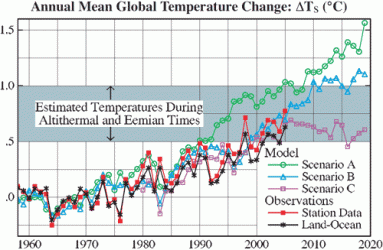ScienceRocks
Democrat all the way!
- Banned
- #1
Pacific Northwest Climate Projections Outlined in New Report
November 5, 2013
Pacific Northwest Climate Projections Outlined in New Report | The Yale Forum on Climate Change & The Media
November 5, 2013
Lots of change is in the air in a warmer Pacific Northwest, a new analysis projects, many posing significant ecological and economic concerns for the region.
A new report paints a sobering picture of and projections for the Pacific Northwest in a warming world.
The 2013 Northwest Climate Assessment Report, prepared by Oregon State Universitys Oregon Climate Change Research Institute and scientists from across the region, addresses a number of projected impacts:
Modeling that projects warming of between 2 and 8.5 degrees F in the period from the last three decades of the nineties to 2041-2070, with the lower end possible only if greenhouse gas emissions are significantly reduced.
Annual precipitation declines of 5 to 14 percent by 2041-2070. The report points to some models showing decreases and some increases for every season, but most models project lower summer rainfall by as much as 35 percent.
Dry years will become dryer, but some basins will likely be buffered by groundwater.
Continued warming of rivers, lakes, and wetlands, with risks to aquatic species and extent of suitable habitat for many species, in particular salmonids and other species already near their upper thermal tolerance.
With local variations, sea-level increases of between 4 and 56 inches by 2100, compared to 2000. Shrinking of coastal marshes unable to migrate upshore.
More CO2 in northwest marine waters and more acidity and nutrient runoff for some of the worlds most acidified conditions, hindering some marine organisms.
Spatial distribution of suitable climate for many important tree species and vegetation types may change considerably by the end of the 21st century.
Prospects for increases in PNW areas subject to wildfires, increasing by about 900 square miles from the 1980-2006 average, a factor of 2.5 from the 1980-2006 average.
The report advises that federal and state policies governing management and harvest may impact the economy as much as any effect attributable to climate change and that forestry productivity gains in a higher-CO2 climate and warmer temperatures may be offset by insect and disease outbreaks and expanded wildfires, for instance from Swiss needle damages to Douglas fir trees.
On public health implications, the report says the PNW vulnerability remains relatively low, but it projects that adverse impacts of climate change outweigh any positive ones. It points to risks of more heart-related deaths, worse air quality and more allergenic disease, and emergence of more infectious diseases and more mental health problems.
Pacific Northwest Climate Projections Outlined in New Report | The Yale Forum on Climate Change & The Media


